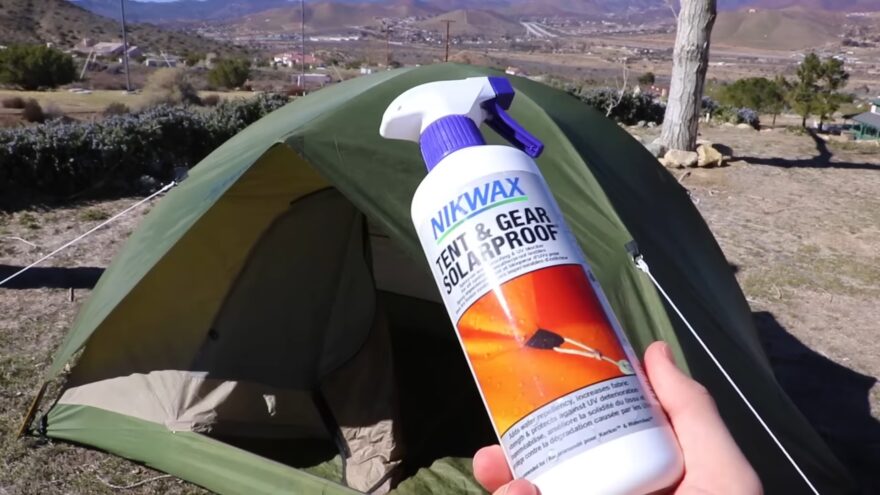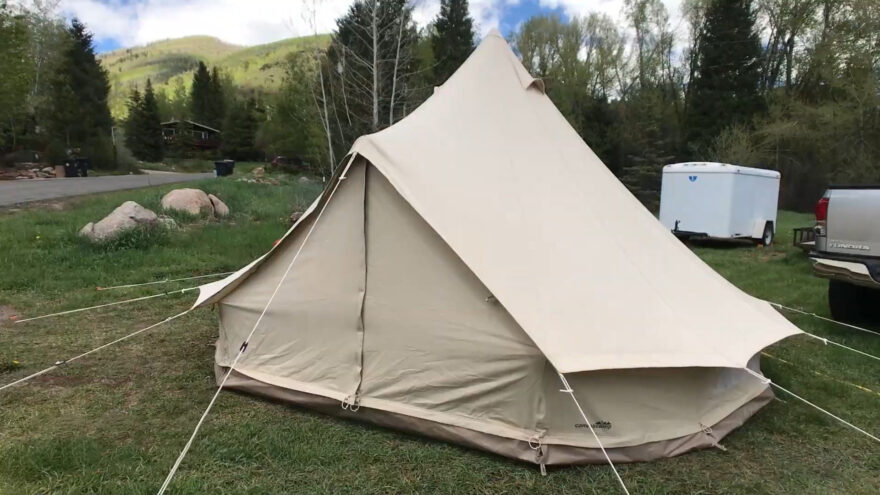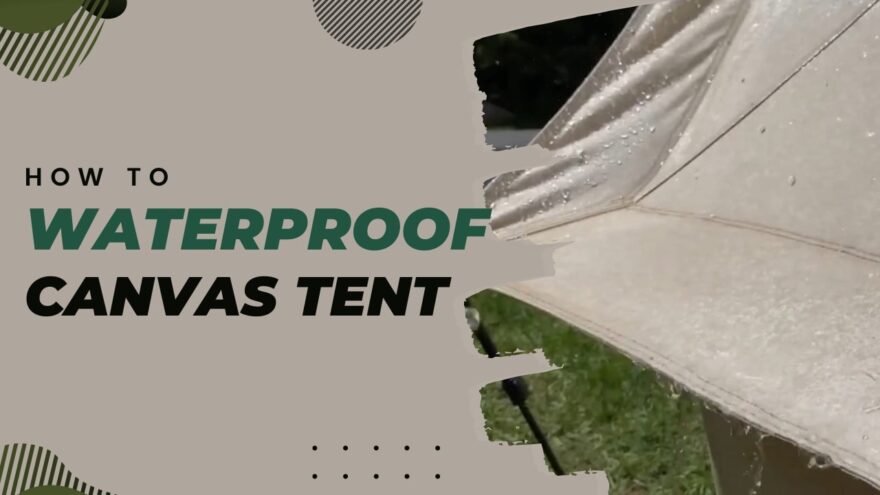Waterproofing your canvas tent is important to prolong its life and keep you dry during rainy weather. There are a few different methods you can use to waterproof your tent, and which one you choose will depend on the severity of the weather and how often you plan to use your tent.
For instance, if you only need light protection from rain, you can simply treat your tent with a water-repellent spray. However, if you’re expecting heavy rains or want to use your tent in wet conditions frequently, you’ll need to apply a waterproofing sealant. Read on for more information about how to waterproof your canvas tent.
How To Waterproof A Canvas Tent Simple Guide
It’s always a good idea to waterproof your canvas tent before taking it out camping. Even if the weather forecast looks fine, you never know when a sudden rain shower can hit. The waterproofing of your tent will help to keep you dry and comfortable, and it will also help to prolong the life of your tent.
There are a few different methods you can use to waterproof your canvas tent. The best option for you will depend on the severity of the weather and how often you plan to use your tent in wet conditions.
“While you’re preparing for your camping trip and learning how to waterproof your canvas tent to protect against rain, you may also want to read our guide on keeping your beverages cold and refreshing in a Yeti cooler for the duration of your adventure.”
Here are some simple tips on how to waterproof a canvas tent:
1. Use A Water Repellent Spray

If you only need light protection from rain, you can treat your tent with a water repellent spray. This will help to keep the rain from penetrating the fabric and wetting you and your gear. In order to avoid any damage to your tent, it is recommended that you test the spray on a small, inconspicuous area first to make sure it will not cause any issues.
2. Apply A Waterproofing Sealant
If you’re expecting heavy rains or want to use your tent in wet conditions frequently, you’ll need to apply a waterproofing sealant.
There are a number of different sealants available, so be sure to read the instructions carefully and choose one that is suitable for your tent material. Apply the sealant according to the manufacturer’s instructions, and be sure to test it on a small patch of fabric first to make sure there is no adverse reaction.
3. Cover Your Tent With A Tarp

If you’re camping in a very wet or windy area, it’s a good idea to cover your tent with a tarp. A good way to protect yourself and your gear from the elements is by adding an extra layer of protection to your gear.
4. Paraffin Wax/Oil Method
If you’re looking for a more long-term waterproofing solution, you can try treating your canvas tent with paraffin wax or oil. This will help to form a watertight seal on the fabric and will keep the rain from penetrating.
To apply this method, first clean the surface of your tent with a damp cloth. Then, using a paintbrush, apply a thin layer of paraffin wax or oil to the fabric. Before you use your tent, make sure that it has dried completely.
Be sure to reapply the wax or oil every few months, or whenever you notice that the fabric is starting to look wet.
5. Silicone Waterproofing Method
If you want to waterproof your tent permanently, you can apply a silicone sealant. By doing this, you will be forming a watertight barrier on the fabric, which will keep the rain from penetrating into the fabric.
To apply this method, first clean the surface of your tent with a damp cloth. Then, using a paint brush or roller, apply a thin layer of silicone sealant to the fabric. Let it dry completely before using your tent.
Canvas Tent Maintenance Tips
In addition to waterproofing your tent, there are a few other maintenance tips you can follow to help prolong its life.
Don’t forget to take a look at our guide on how to safely use a Mr. Buddy Heater inside your tent, ensuring a warm and cozy camping experience.”
Here are some simple tips on how to care for your canvas tent:
1. Keep It Clean
Be sure to clean your canvas tent regularly, both inside and out. Remove any dirt, dust or debris that has accumulated, and be sure to sweep out the inside of your tent to remove any dirt or sand. If you’re using your tent in a particularly dusty area, you may need to clean it more frequently.
2. Protect It From The Sun

If you’re going to be storing your canvas tent for an extended period of time, be sure to protect from the sun. UV rays can damage the fabric and cause it to fade, so it’s a good idea to store your tent in a cool, dark place.
3. Repair Any Damage
If you notice any holes or tears in your tent, be sure to repair them as soon as possible. If left unchecked, small problems can quickly escalate into larger problems, so it is best to nip the problem in the bud as soon as possible.
Following these simple tips will help you get the most out of your canvas tent and will prolong its life.
Frequently Asked Questions
1. How can I waterproof my canvas naturally?
You can waterproof your canvas tent naturally by using a mixture of beeswax and linseed oil. First, clean the surface of your tent with a damp cloth. Then, apply a thin layer of the beeswax/linseed oil mixture to the fabric. Let it dry completely before using your tent.
2. How do you seal outdoor canvas?
Sealing outdoor canvas is fairly simple. First, clean the surface of the fabric with a damp cloth. Then, apply a thin layer of sealant to the fabric. Let it dry completely before using your tent. Be sure to reapply the sealant every few months, or whenever you notice that the fabric is starting to look wet.
3. What is the best waterproof canvas product?
There are a number of different products you can use to waterproof canvas, including silicone sealants, paraffin wax and oil, and commercial waterproofing sprays. Choose the product that is best suited for your needs and follow the manufacturer’s instructions carefully.
4. How do you apply waterproofing to the canvas?

Applying waterproofing to canvas is fairly simple. First, clean the surface of your tent with a damp cloth. Then, using a paint brush or roller, apply a thin layer of waterproofing sealant to the fabric.
Let it dry completely before using your tent. Be sure to reapply the sealant every few months, or whenever you notice that the fabric is starting to look wet.
5. What is the best waterproofing for canvas?
There are a number of different products you can use to waterproof canvas, including silicone sealants, paraffin wax and oil, and commercial waterproofing sprays. Choose the product that is best suited for your needs and follow the manufacturer’s instructions carefully.
6. Can I use a sealant on my cotton tent?
You can use a sealant on your cotton tent, but be sure to choose a product that is specifically designed for use on cotton fabrics.
Follow the manufacturer’s instructions carefully, and be sure to test the sealant on a small area of the fabric before applying it to the entire tent.
7. Is canvas waterproof?
No, canvas is not naturally waterproof. However, you can waterproof your canvas tent by using a sealant or coating. Be sure to reapply the waterproofing every few months, or whenever you notice that the fabric is starting to look wet.
Final words
The waterproofing of a tent is one of the most important aspects of camping. It can be the difference between a miserable experience and a great one. By understanding how to waterproof canvas tents, you can make sure that your next camping trip is enjoyable, regardless of the weather conditions.
With these simple tips, you can keep your canvas tent in good condition and make sure it lasts for many years to come. So, don’t wait any longer and waterproof your tent today!
Related Posts:
- How to Tell If Your Roof Tent Is Truly Waterproof? -…
- Stay on the Red Rock Scenic Byway - Perfect Road…
- How To Tent With Foil [2024 Guide] - Methods to Make…
- Top 10 Best Camping Lighter 2024 - Windproof &…
- Top 5 Fishing Spots Around the World You Don’t Want to Miss
- How Long Does A Yeti Cooler Stay Cold While Camping…











